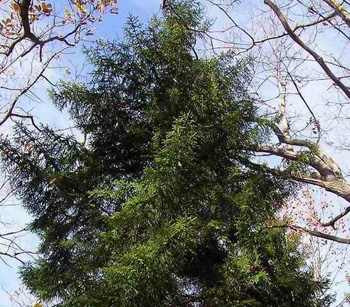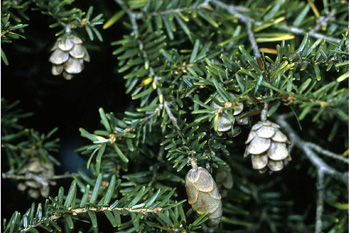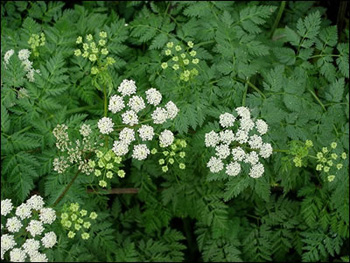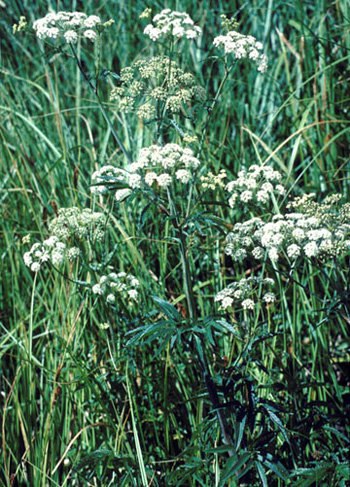Contents:
Common Names | Parts Usually Used | Plant(s) & Culture | Where Found | Medicinal Properties
Uses | Formulas or Dosages | Warning | Bibliography
Scientific Names

- Hemlock Spruce
- Tsuga canadensis L.
- Pine family
- Poison Hemlock
- Conium maculatum L.
- Parsley family
- Water Hemlock
- Cicuta maculata L.
Common Names
Parts Usually Used
Poison hemlock: Poison—identify
to avoid!
Hemlock spruce: inner bark and leaves
Back to Top

Description of Plant(s) and Culture
Poison hemlock:
A species of evergreen plant; the volatile oil extracted from dried, unripe fruit of Conium maculatum, poison hemlock or a poison made from the hemlock. A European plant with compound umbels of small, white flowers and finely divided leaves. A branched perennial, 2-6 feet tall. Stems are hollow, grooved; purple-spotted. Leaves are carrot-like, but in overall outline more like an equilateral triangle, and with more divisions; leaves ill-scented when bruised. Leafstalks are hairless. Flowers are white, in umbels; May to August. Similar in appearance to caraway, valerian, Queen Anne’s lace, wild carrot, etc. Care should be taken in identifying the hemlock plant;
Water hemlock:
A North American and Asiatic evergreen tree of the pine family, with drooping branches and short needles; the bark is used in tanning.
Hemlock spruce:
A North American evergreen tree growing 50-100 feet high; the bark is a dull brownish-gray on the outside and red underneath and is made up of large, rough scales. The leaves are short and needle-like, and both male and female flowers grow in catkins. The woody seed cones are less than an inch long. Needles are flat; 5/16-9/16 inches long; on short slender stalks. Needles are bright green above, silvery whitish beneath. Cones drooping, to 1 inch long, with few scales; scales rounded. The oleoresin derived from the bark is dark reddish brown, opaque, and has a characteristic turpentine-like fragrance. This is the kind of bark tanners use in making shoe leather.
Back to Top

Where Found
Poison Hemlock is found in waste ground in most of the United States.
Hemlock spruce: found in mountain ravines and woods and in swampy areas. Hills in rocky woods. Nova Scotia to Maryland; Georgia mountains; Alabama to Kentucky, Indiana, eastern Minnesota.
Back to Top

Medicinal Properties
Poison hemlock: whole plant a traditional folk cancer remedy, narcotic, sedative, analgesic, spasmolytic, anti-aphrodisiac.
Hemlock spruce: astringent, diaphoretic, diuretic.
Back to Top
Uses
Hemlock spruce: a tea of the inner bark or the young twigs is helpful in kidney and bladder problems and makes a good enema for diarrhea. Use it also to wash external sores and ulcers and as a gargle or mouthwash for mouth, canker sores, gangrene, and throat problems. Put powdered bark in the shoes for tender or sweaty feet or for foot odor.
Hemlock spruce is the common hemlock tree, one of the old home remedies. The leaves can be used, but should not be taken during pregnancy. It can be used in dropsy; it increases the flow of urine. May be used as a douche for leukorrhea; is good for uterine problems, and a remedy for colon trouble and diarrhea when used as an enema.
Native Americans used tea made from leafy twig tips in steam baths for rheumatism, colds, fevers, diarrhea, coughs, stomach troubles, and scurvy. Bark is very astringent.
Back to Top
Formulas or Dosages
Hemlock spruce:
Infusion: for internal use, steep 1 tsp. inner bark or twigs in 1 cup boiling water.
Decoction: for external use, simmer 1 tsp. bark or twigs in 1 cup of water for 10 minutes.
It is better to take smaller doses more often.
Back to Top
Warning
Poison hemlock is a deadly poison. Ingestion can be lethal. Contact can cause dermatitis; juice is highly toxic. The young poison hemlock plant closely resembles Osha root.
Symptoms of hemlock poisoning: weakness, drowsiness, nausea, vomiting, difficult breathing, paralysis, and death.
Treatment for this poisoning: empty stomach by means of a stomach pump or an emetic. Give cathartic. Treat respiratory failure with artificial respiration and oxygen.
Hemlock spruce is not considered poisonous when inner bark and twigs are used but should never be used during pregnancy.
Use only under medical supervision.
Back to Top
Bibliography
![]() Back to Eden
Back to Eden, by Jethro Kloss; Back to Eden Publishing Co., Loma Linda, CA 92354, Original copyright 1939, revised edition 1994
![]() Indian Herbalogy of North America
Indian Herbalogy of North America, by Alma R. Hutchens, Shambala Publications, Inc., Horticultural Hall, 300 Massachusetts Avenue, Boston, Massachusetts 02115, 1973
![]() Culpeper’s Complete Herbal & English Physician: Updated With 117 Modern Herbs
Culpeper’s Complete Herbal & English Physician: Updated With 117 Modern Herbs, by Nicholas Culpeper, Meyerbooks, publisher, PO Box 427, Glenwood, Illinois 60425, 1990, (reprint of 1814)
![]() The Herb Book
The Herb Book, by John Lust, Bantam Books, 666 Fifth Avenue, New York, NY. copyright 1974.
![]() Eastern/Central Medicinal Plants
Eastern/Central Medicinal Plants, by Steven Foster and James A. Duke., Houghton Mifflin Company, 215 Park Avenue South, New York, NY 10000
 How Indians Use Wild Plants for Food, Medicine & Crafts
How Indians Use Wild Plants for Food, Medicine & Crafts, by Frances Densmore, Dover Publications, Inc., 180 Varick Street, New York, NY 10014, first printed by the United States Government Printing Office, Washington, in 1928, this Dover edition 1974
![]() American Folk Medicine
American Folk Medicine, by Clarence Meyer, Meyerbooks, publisher, PO Box 427, Glenwood, Illinois 60425, 1973
 Taber’s Cyclopedic Medical Dictionary
Taber’s Cyclopedic Medical Dictionary, 15th Edition, F. A. Davis Company, 1915 Arch Street, Philadelphia, PA 19103
![]() Webster’s New World Dictionary
Webster’s New World Dictionary, Third College Edition, Victoria Neufeldt, Editor in Chief, New World Dictionaries: A Division of Simon & Schuster, Inc., 15 Columbus Circle, New York, NY 10023
 The Rodale Herb Book: How to Use, Grow, and Buy Nature’s Miracle Plants (An Organic gardening and farming book)
The Rodale Herb Book: How to Use, Grow, and Buy Nature’s Miracle Plants (An Organic gardening and farming book), edited by William H. Hylton, Rodale Press, Inc. Emmaus, PA, 18049., 1974
